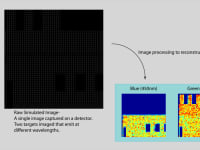
Every year chemical manufacturing companies spend millions of dollars and thousands of man hours attempting to increase safety and prevent dangerous chemical leaks and accidents. Regardless of these efforts, dangerous chemical leaks still occur. The US Chemical Safety Board, an independent federal agency that investigates chemical accidents, has maintained a thorough list of accidents for more than twenty years with 13 incidents currently under investigation. The chemical manufacturing industry needs better technological solutions to prevent these dangerous and costly accidents.
We propose a new device called the spectral snapshot camera (SSC), a new remote sensing tool in chemical safety and leak detection. The SSC captures hyperspectral images that permit sensitive detection of chemical constituents. Due to the imaging capability of this system, not only could it tell if a particular chemical leak occurred, it could tell where a leak was within the field of view.
We capture hyperspectral image data in a single snapshot through a method that is completely new in the snapshot imaging field. By applying our knowledge of plenoptic photography, we are able to solve the snapshot hyperspectral imaging problem easier than current solutions. The device takes a traditional imaging lens and places a lenslet array at the image plane. This lenslet array captures micro images and relays them to the sensor. These micro images are then spread spectrally with an diffraction grating. Image processing is then performed that separates the spatial and spectral data on the sensor, and produces a series of images at different wavelengths.
Potential benefits from using the SSC include reduced safety cost for chemical manufacturers, increased safety from environmental contamination, and reduced risk of human exposure to hazardous chemicals during manufacturing.
There are numerous applications for snapshot hyperspectral imaging devices. We plan to first penetrate the chemical hazard and manufacturing safety market. This device would be able to automatically monitor for dangerous chemical leaks or spills. Coupled with software integrated with current safety systems, this device would be able to automatically shut down specific systems if a leak was detected, saving lives and reducing cost.
Most snapshot spectral imaging systems rely on a large number of optical elements, expensive holographic spectral dispersers, or custom manufactured micro-mirror elements. The SSC is unique due to its extremely simple manufacturing method. A traditional imaging optic, lenslet array, diffraction grating, and optical sensor are the only required elements. Because these elements are so prevalent in the optical community, a fully functioning SSC could easily be manufactured for an order of magnitude less than current snapshot imaging systems ($1,000's instead of $10,000's).
The SSC has the potential to be a disruptive sensing and safety system in chemical manufacturing facilities. By using a new method to capture spectral and spatial data we can create low cost, accurate chemical detection systems that can automatically detect and alert users to dangerous chemical leaks.
-
Awards
-
 2012 Top 100 Entries
2012 Top 100 Entries
Voting
-
ABOUT THE ENTRANT
- Name:Gabriel Birch
- Type of entry:teamTeam members:Charles LaCasse, University of Arizona College of Optical Sciences
- Profession:
- Number of times previously entering contest:never
- Gabriel's favorite design and analysis tools:Matlab for image processing, Zemax non-sequential ray tracing for real image simulations. Together you can close the loop and design fully simulated optical designs and image processing algorithms.
- Gabriel's hobbies and activities:Exploring new foods, piano and cello
- Gabriel is inspired by:Optical engineering exists in an interesting place within the realm of science and engineering. A multidisciplinary approach is absolutely necessary when approaching most optical problems. Mechanical design, physics, ancient geometrical designs, quantum mechanics, material science, and chemistry all combine into challenging, fantastic problems to be solved. I find inspiration in unique solutions outside my own discipline. Listening and discussing current research often leads to many new ideas.
- Software used for this entry:Zemax, Matlab
- Patent status:pending

















